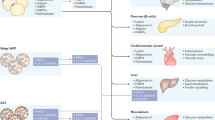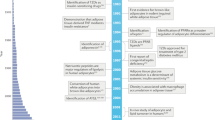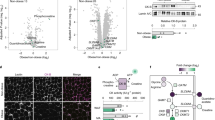Abstract
The importance of white adipose tissue in the control of energy balance is now firmly recognized. In addition to fuel storage, adipocytes secrete an array of proteins factors (adipokines), which regulate multiple physiological and metabolic processes as well as influence body fat accumulation. Zinc-α2-glycoprotein (ZAG), a lipid mobilizing factor initially characterized as a tumor product associated with cachexia, has recently been identified as a novel adipokine. Although the exact role of ZAG in adipose tissue remains to be clarified, there is evidence that ZAG expression appears to be inversely related to adiposity, being upregulated in cachexia whereas reduced in obesity. Investigations on the regulation of ZAG give insights into its potential function in adipose tissue with a link to lipid mobilization and an anti-inflammatory action. Recent work shows that ZAG stimulates adiponectin secretion by human adipocytes. Data from genetic studies suggest that ZAG may be a candidate gene for body weight regulation; this is supported by the demonstration that ZAG-knockout mice are susceptible to weight gain, whereas transgenic mice overexpressing ZAG exhibit weight loss. The present review summarizes these new perspectives of ZAG and the potential mechanisms by which it might modulate adipose tissue mass and function.
This is a preview of subscription content, access via your institution
Access options
Subscribe to this journal
Receive 12 print issues and online access
$259.00 per year
only $21.58 per issue
Buy this article
- Purchase on Springer Link
- Instant access to full article PDF
Prices may be subject to local taxes which are calculated during checkout


Similar content being viewed by others
References
Spiegelman BM, Flier JS . Obesity and the regulation of energy balance. Cell 2001; 104: 531–543.
Mohamed-Ali V, Pinkney JH, Coppack SW . Adipose tissue as an endocrine and paracrine organ. Int J Obes Relat Metab Disord 1998; 22: 1145–1158.
Ahima RS, Flier JS . Adipose tissue as an endocrine organ. Trends Endocrinol Metab 2000; 11: 327–332.
Trayhurn P, Beattie JH . Physiological role of adipose tissue: white adipose tissue as an endocrine and secretory organ. Proc Nutr Soc 2001; 60: 329–339.
Rajala MW, Scherer PE . Minireview: the adipocyte—at the crossroads of energy homeostasis, inflammation, and atherosclerosis. Endocrinology 2003; 144: 3765–3773.
Trayhurn P, Wood IS . Adipokines: inflammation and the pleiotropic role of white adipose tissue. Br J Nutr 2004; 92: 347–355.
Trayhurn P, Bing C, Wood IS . Adipose tissue and adipokines—energy regulation from the human perspective. J Nutr 2006; 136: 1935S–1939S.
Fruhbeck G, Gomez-Ambrosi J, Muruzabal FJ, Burrell MA . The adipocyte: a model for integration of endocrine and metabolic signaling in energy metabolism regulation. Am J Physiol Endocrinol Metab 2001; 280: E827–E847.
Scherer PE . Adipose tissue: from lipid storage compartment to endocrine organ. Diabetes 2006; 55: 1537–1545.
Trayhurn P, Bing C . Appetite and energy balance signals from adipocytes. Philos Trans R Soc Lond B Biol Sci 2006; 361: 1237–1249.
Bluher M . Transgenic animal models for the study of adipose tissue biology. Best Pract Res Clin Endocrinol Metab 2005; 19: 605–623.
Rosen ED, Spiegelman BM . Adipocytes as regulators of energy balance and glucose homeostasis. Nature 2006; 444: 847–853.
Bing C, Bao Y, Jenkins J, Sanders P, Manieri M, Cinti S et al. Zinc-alpha2-glycoprotein, a lipid mobilizing factor, is expressed in adipocytes and is up-regulated in mice with cancer cachexia. Proc Natl Acad Sci USA 2004; 101: 2500–2505.
Bao Y, Bing C, Hunter L, Jenkins JR, Wabitsch M, Trayhurn P . Zinc-alpha2-glycoprotein, a lipid mobilizing factor, is expressed and secreted by human (SGBS) adipocytes. FEBS Lett 2005; 579: 41–47.
Burgi W, Schmid K . Preparation and properties of Zn-alpha 2-glycoprotein of normal human plasma. J Biol Chem 1961; 236: 1066–1074.
Tada T, Ohkubo I, Niwa M, Sasaki M, Tateyama H, Eimoto T . Immunohistochemical localization of Zn-alpha 2-glycoprotein in normal human tissues. J Histochem Cytochem 1991; 39: 1221–1226.
Diez-Itza I, Sanchez LM, Allende MT, Vizoso F, Ruibal A, Lopez-Otin C . Zn-alpha 2-glycoprotein levels in breast cancer cytosols and correlation with clinical, histological and biochemical parameters. Eur J Cancer 1993; 29A: 1256–1260.
Hale LP, Price DT, Sanchez LM, Demark-Wahnefried W, Madden JF . Zinc alpha-2-glycoprotein is expressed by malignant prostatic epithelium and may serve as a potential serum marker for prostate cancer. Clin Cancer Res 2001; 7: 846–853.
Irmak S, Tilki D, Heukeshoven J, Oliveira-Ferrer L, Friedrich M, Huland H et al. Stage-dependent increase of orosomucoid and zinc-alpha2-glycoprotein in urinary bladder cancer. Proteomics 2005; 5: 4296–4304.
Albertus DL, Seder CW, Chen G, Wang X, Hartojo W, Lin L et al. AZGP1 autoantibody predicts survival and histone deacetylase inhibitors increase expression in lung adenocarcinoma. J Thorac Oncol 2008; 3: 1236–1244.
Bondar OP, Barnidge DR, Klee EW, Davis BJ, Klee GG . LC-MS/MS quantification of Zn-alpha2 glycoprotein: a potential serum biomarker for prostate cancer. Clin Chem 2007; 53: 673–678.
Abdul-Rahman PS, Lim BK, Hashim OH . Expression of high-abundance proteins in sera of patients with endometrial and cervical cancers: analysis using 2-DE with silver staining and lectin detection methods. Electrophoresis 2007; 28: 1989–1996.
Sanchez LM, Chirino AJ, Bjorkman P . Crystal structure of human ZAG, a fat-depleting factor related to MHC molecules. Science 1999; 283: 1914–1919.
Kennedy MW, Heikema AP, Cooper A, Bjorkman PJ, Sanchez LM . Hydrophobic ligand binding by Zn-alpha 2-glycoprotein, a soluble fat-depleting factor related to major histocompatibility complex proteins. J Biol Chem 2001; 276: 35008–35013.
McDermott LC, Freel JA, West AP, Bjorkman PJ, Kennedy MW . Zn-alpha2-glycoprotein, an MHC class I-related glycoprotein regulator of adipose tissues: modification or abrogation of ligand binding by site-directed mutagenesis. Biochemistry 2006; 45: 2035–2041.
Ueyama H, Naitoh H, Ohkubo I . Structure and expression of rat and mouse mRNAs for Zn-alpha 2-glycoprotein. J Biochem (Tokyo) 1994; 116: 677–681.
He N, Brysk H, Tyring SK, Ohkubo I, Brysk MM . Zinc-alpha(2)-glycoprotein hinders cell proliferation and reduces cdc2 expression. J Cell Biochem 2001; 81: 162–169.
Schmitt R, Marlier A, Cantley LG . Zag expression during aging suppresses proliferation after kidney injury. J Am Soc Nephrol 2008; 19: 2375–2383.
Hale LP . Zinc alpha-2-glycoprotein regulates melanin production by normal and malignant melanocytes. J Invest Dermatol 2002; 119: 464–470.
Burgi W, Simonen S, Baudner S, Schmid K . Unusually high concentrations of Zn alpha 2-glycoprotein and the lack of alpha 2HS-glycoprotein in human ejaculates. Clin Chem 1989; 35: 1649–1650.
Ding Z, Qu F, Guo W, Ying X, Wu M, Zhang Y . Identification of sperm forward motility-related proteins in human seminal plasma. Mol Reprod Dev 2007; 74: 1124–1131.
Bing C, Trayhurn P . New insights into adipose tissue atrophy in cancer cachexia. Proc Nutr Soc 2009; 68: 385–392.
Todorov PT, McDevitt TM, Meyer DJ, Ueyama H, Ohkubo I, Tisdale MJ . Purification and characterization of a tumor lipid-mobilizing factor. Cancer Res 1998; 58: 2353–2358.
Hirai K, Hussey HJ, Barber MD, Price SA, Tisdale MJ . Biological evaluation of a lipid-mobilizing factor isolated from the urine of cancer patients. Cancer Res 1998; 58: 2359–2365.
Russell ST, Hirai K, Tisdale MJ . Role of beta3-adrenergic receptors in the action of a tumour lipid mobilizing factor. Br J Cancer 2002; 86: 424–428.
Russell ST, Tisdale MJ . Effect of a tumour-derived lipid-mobilising factor on glucose and lipid metabolism in vivo. Br J Cancer 2002; 87: 580–584.
Russell ST, Tisdale MJ . Antidiabetic properties of zinc-alpha2-glycoprotein in ob/ob mice. Endocrinology 2010; 151: 948–957.
Bing C, Russell ST, Beckett EE, Collins P, Taylor S, Barraclough R et al. Expression of uncoupling proteins-1, -2 and -3 mRNA is induced by an adenocarcinoma-derived lipid-mobilizing factor. Br J Cancer 2002; 86: 612–618.
Cannon B, Nedergaard J . Brown adipose tissue: function and physiological significance. Physiol Rev 2004; 84: 277–359.
Sanders PM, Tisdale MJ . Effect of zinc-alpha2-glycoprotein (ZAG) on expression of uncoupling proteins in skeletal muscle and adipose tissue. Cancer Lett 2004; 212: 71–81.
Mracek T, Ding Q, Tzanavari T, Kos K, Pinkney J, Wilding J et al. The adipokine zinc-alpha2-glycoprotein (ZAG) is downregulated with fat mass expansion in obesity. Clin Endocrinol (Oxf) 2010; 72: 334–341.
Ding Q, Mracek T, Gonzalez-Muniesa P, Kos K, Wilding J, Trayhurn P et al. Identification of macrophage inhibitory cytokine-1 in adipose tissue and its secretion as an adipokine by human adipocytes. Endocrinology 2009; 150: 1688–1696.
Russell ST, Tisdale MJ . The role of glucocorticoids in the induction of zinc-alpha2-glycoprotein expression in adipose tissue in cancer cachexia. Br J Cancer 2005; 92: 876–881.
Pedersen SB, Kristensen K, Richelsen B . Anti-glucocorticoid effects of progesterone in vivo on rat adipose tissue metabolism. Steroids 2003; 68: 543–550.
Djurhuus CB, Gravholt CH, Nielsen S, Pedersen SB, Moller N, Schmitz O . Additive effects of cortisol and growth hormone on regional and systemic lipolysis in humans. Am J Physiol Endocrinol Metab 2004; 286: E488–E494.
Knapp ML, al-Sheibani S, Riches PG, Hanham IW, Phillips RH . Hormonal factors associated with weight loss in patients with advanced breast cancer. Ann Clin Biochem 1991; 28 (Part 5): 480–486.
Russell ST, Tisdale MJ . Effect of eicosapentaenoic acid (EPA) on expression of a lipid mobilizing factor in adipose tissue in cancer cachexia. Prostaglandins Leukot Essent Fatty Acids 2005; 72: 409–414.
Bing C, Taylor S, Tisdale MJ, Williams G . Cachexia in MAC16 adenocarcinoma: suppression of hunger despite normal regulation of leptin, insulin and hypothalamic neuropeptide Y. J Neurochem 2001; 79: 1004–1012.
Capel F, Klimcakova E, Viguerie N, Roussel B, Vitkova M, Kovacikova M et al. Macrophages and adipocytes in human obesity: adipose tissue gene expression and insulin sensitivity during calorie restriction and weight stabilization. Diabetes 2009; 58: 1558–1567.
Tzanavari T, Bing C, Trayhurn P . Postnatal expression of zinc-alpha2-glycoprotein in rat white and brown adipose tissue. Mol Cell Endocrinol 2007; 279: 26–33.
Mracek T, Gao D, Tzanavari T, Bao Y, Xiao X, Stocker C et al. Downregulation of zinc-{alpha}2-glycoprotein in adipose tissue and liver of obese ob/ob mice and by tumour necrosis factor-alpha in adipocytes. J Endocrinol 2010; 204: 165–172.
Gong FY, Zhang SJ, Deng JY, Zhu HJ, Pan H, Li NS et al. Zinc-alpha2-glycoprotein is involved in regulation of body weight through inhibition of lipogenic enzymes in adipose tissue. Int J Obes (Lond) 2009; 33: 1023–1030.
Dahlman I, Kaaman M, Olsson T, Tan GD, Bickerton AS, Wahlen K et al. A unique role of monocyte chemoattractant protein 1 among chemokines in adipose tissue of obese subjects. J Clin Endocrinol Metab 2005; 90: 5834–5840.
Marrades MP, Martinez JA, Moreno-Aliaga MJ . ZAG, a lipid mobilizing adipokine, is downregulated in human obesity. J Physiol Biochem 2008; 64: 61–66.
Selva DM, Lecube A, Hernandez C, Baena JA, Fort JM, Simo R . Lower zinc-alpha2-glycoprotein production by adipose tissue and liver in obese patients unrelated to insulin resistance. J Clin Endocrinol Metab 2009; 94: 4499–4507.
Ceperuelo-Mallafre V, Naf S, Escote X, Caubet E, Gomez JM, Miranda M et al. Circulating and adipose tissue gene expression of zinc-alpha2-glycoprotein in obesity: its relationship with adipokine and lipolytic gene markers in subcutaneous and visceral fat. J Clin Endocrinol Metab 2009; 94: 5062–5069.
Stejskal D, Karpisek M, Reutova H, Stejskal P, Kotolova H, Kollar P . Determination of serum zinc-alpha-2-glycoprotein in patients with metabolic syndrome by a new ELISA. Clin Biochem 2008; 41: 313–316.
Yeung DC, Lam KS, Wang Y, Tso AW, Xu A . Serum zinc-alpha2-glycoprotein correlates with adiposity, triglycerides, and the key components of the metabolic syndrome in chinese subjects. J Clin Endocrinol Metab 2009; 94: 2531–2536.
Gohda T, Makita Y, Shike T, Tanimoto M, Funabiki K, Horikoshi S et al. Identification of epistatic interaction involved in obesity using the KK/Ta mouse as a Type 2 diabetes model: is Zn-alpha2 glycoprotein-1 a candidate gene for obesity? Diabetes 2003; 52: 2175–2181.
Rolli V, Radosavljevic M, Astier V, Macquin C, Castan-Laurell I, Visentin V et al. Lipolysis is altered in MHC class I zinc-alpha(2)-glycoprotein deficient mice. FEBS Lett 2007; 581: 394–400.
Olofsson LE, Olsson B, Lystig T, Jacobson P, Jernas M, Sjoholm K et al. Preliminary report: Zn-alpha2-glycoprotein genotype and serum levels are associated with serum lipids. Metabolism 2010; e-pub ahead of print, doi:10.1016/j.metabol.2009.12.006.
Yamauchi T, Kamon J, Waki H, Terauchi Y, Kubota N, Hara K et al. The fat-derived hormone adiponectin reverses insulin resistance associated with both lipoatrophy and obesity. Nat Med 2001; 7: 941–946.
Bullo M, Garcia-Lorda P, Megias I, Salas-Salvado J . Systemic inflammation, adipose tissue tumor necrosis factor, and leptin expression. Obes Res 2003; 11: 525–531.
Sartipy P, Loskutoff DJ . Monocyte chemoattractant protein 1 in obesity and insulin resistance. Proc Natl Acad Sci USA 2003; 100: 7265–7270.
Bruun JM, Lihn AS, Verdich C, Pedersen SB, Toubro S, Astrup A et al. Regulation of adiponectin by adipose tissue-derived cytokines: in vivo and in vitro investigations in humans. Am J Physiol Endocrinol Metab 2003; 285: E527–E533.
Whitehead JP, Richards AA, Hickman IJ, Macdonald GA, Prins JB . Adiponectin--a key adipokine in the metabolic syndrome. Diabetes Obes Metab 2006; 8: 264–280.
Zhang Y, Proenca R, Maffei M, Barone M, Leopold L, Friedman JM . Positional cloning of the mouse obese gene and its human homologue. Nature 1994; 372: 425–432.
Orci L, Cook WS, Ravazzola M, Wang MY, Park BH, Montesano R et al. Rapid transformation of white adipocytes into fat-oxidizing machines. Proc Natl Acad Sci USA 2004; 101: 2058–2063.
Kettaneh A, Heude B, Romon M, Oppert JM, Borys JM, Balkau B et al. High plasma leptin predicts an increase in subcutaneous adiposity in children and adults. Eur J Clin Nutr 2007; 61: 719–726.
Mracek T, Ding Q, Tzanavari T, Pinkney J, Kos K, Wilding J et al. The adipokine zinc-α2-glycoprotein is downregulated with fat mass expansion in obesity. Obesity Facts 2009; 2: 181.
Acknowledgements
We thank Dr Y Bao, Dr T Tzanavari and Dr Q Ding for their contribution to our studies on ZAG. PT is a member of COST BM0602. This work was prepared with financial support from the University of Liverpool R&D Fund, the Biotechnology and Biological Sciences Research Council (BBE015379) and the Medical Research Council (87972).
Author information
Authors and Affiliations
Corresponding author
Ethics declarations
Competing interests
The authors declare no conflict of interest.
Rights and permissions
About this article
Cite this article
Bing, C., Mracek, T., Gao, D. et al. Zinc-α2-glycoprotein: an adipokine modulator of body fat mass?. Int J Obes 34, 1559–1565 (2010). https://doi.org/10.1038/ijo.2010.105
Received:
Revised:
Accepted:
Published:
Issue Date:
DOI: https://doi.org/10.1038/ijo.2010.105
Keywords
This article is cited by
-
Selenium, Zinc, Chromium, and Vanadium Levels in Serum, Hair, and Urine Samples of Obese Adults Assessed by Inductively Coupled Plasma Mass Spectrometry
Biological Trace Element Research (2021)
-
Role of Zinc in Zinc-α2-Glycoprotein Metabolism in Obesity: a Review of Literature
Biological Trace Element Research (2020)
-
Salivary Proteomic Analysis of Betel Nut (Areca catechu) Consumers by Mass Spectrometry Revealed Primary Indication of Oral Malignancies
International Journal of Peptide Research and Therapeutics (2020)
-
Inter-tissue communication in cancer cachexia
Nature Reviews Endocrinology (2019)
-
Proteomics and multivariate modelling reveal sex-specific alterations in distinct regions of human carotid atheroma
Biology of Sex Differences (2018)



